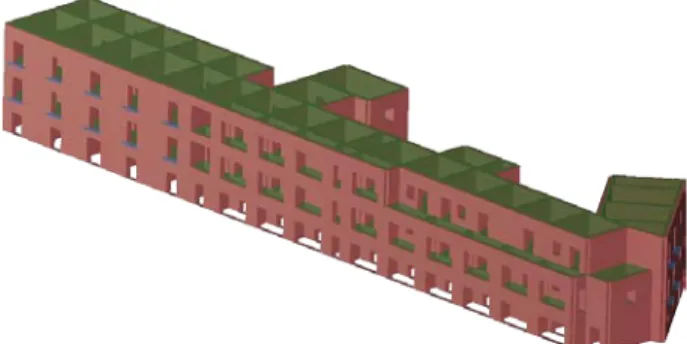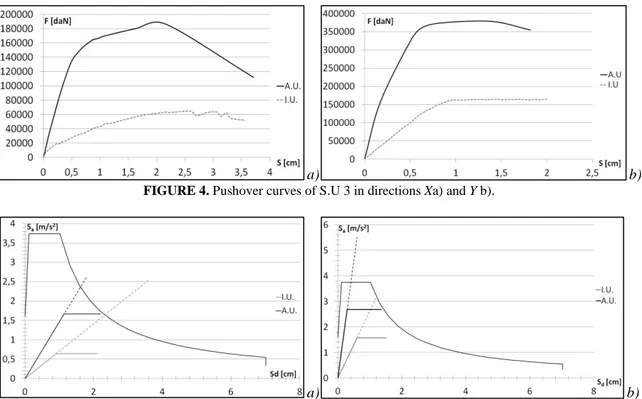On the influence of the aggregate condition on the vibration
period of masonry buildings:
a case study in the district of Naples
Antonio Formisano
a, Nicola Chieffo
b, Dario Monaco
c, Francesco Fabbrocino
d a,cUniversity of Naples “Federico II”, b,dPegaso Telematic UniversityAbstract. The present paper deals with the seismic investigation of a masonry building aggregate within the city of Bacoli (district of Naples) through quick and mechanical analyses with the initial target of evaluating the vibration periods of the individual Structural Units (S.U.) constituting the compound. In conclusion the comparison in terms of seismic vulnerability indexes between S.U. included in the aggregate, distinguishing the position (head or intermediate) in the compound, and the same S.U. considered as isolated constructions has been done.
Keywords: Seismic vulnerability, masonry aggregates, quick analysis, pushover analysis, vibration period.
The historical centre of Bacoli
The settlement system of the historical centre of Bacoli (district of Naples) (Fig. 1) expanded significantly since the post-war period, reaching its maximum growth particularly in the '80s. It consists mainly of masonry buildings: the oldest ones are inserted into compounds, they being statically dependent each to other, whereas those more recently erected are arranged as isolated structures (about 60%).
FIGURE 1. Overview of the historic centre of Bacoli.
The study deals with the behaviour of masonry building aggregates falling in the above historical centre through the analysis of a case study. The acquisition of information necessary for the typological characterisation of the aggregate under investigation has been carried out by filling the CAR.TI.S form. The seismic vulnerability analysis has been conducted through a quick-mechanical approach. The quick analysis has been performed by using a vulnerability form for historical aggregates, while the mechanical one has been carried out through the 3Muri calculation program. With the latter analysis approach, by modelling the entire aggregate, it has been possible to assess the earthquake vulnerability index, as well as the vibration period, of the individual structural units integrated in the building complex for seismic check purpose.
The CAR.TI.S form
The first level CAR.TI.S form, based on the first level procedure “SAVE” (Zuccaro and Cacace, 2015), is aimed at detecting the building types prevalent in the municipal areas, which are called sectors. These areas are characterised by homogenous urban fabrics and construction techniques. The acquisition of information for filling
the form is made by the user with the help of one or more local technicians having a deep knowledge of the study area. The building sector under study is composed of masonry buildings distributed according to both isolated configurations (60%) and aggregate ones (40%). The investigated building aggregate is placed in this sector and it is composed of six S.U. (Fig. 2). The S.U. have an almost regular shape with a supporting structure made of 80 cm average thick tuff stones. They develop on three floors aboveground with a total height of 12 m. Horizontal intermediate and roof structures are made of both mixed steel-tile floors and in-situ casted r.c. floors.
FIGURE 2. The building aggregate under study: subdivision in S.U.
The quick analysis
The quick approach permits the seismic vulnerability assessment of building aggregates by adding to the usual ten vulnerability parameters (Benedetti and Petrini, 1984) five more factors to specifically consider the interactions among different S.U. (Formisano et al., 2010a; 2010b; 2011). Since a score is assigned to four classes defined for each parameter, which is characterised by a given weight, the quick vulnerability index (Iv) is firstly calculated as
the sum of the scores multiplied by their respective weights and then normalised in the range [0-1] (Iv,norm) (Table i). TABLE i). Quick vulnerability indexes of the aggregate S.U.
Vulnerability Index
Building 1 2 3 4 5 6
Iv,norm 0.24 0.19 0.18 0.29 0.20 0.27
The mechanical analyses
The seismic behaviour of the building aggregate has been studied by means of non-linear static analyses performed through the 3Muri calculation program (Formisano et al., 2015; Maio et al., 2015). After assessing the seismic response of the isolated units (I.U.) along the main analysis directions, the behaviours of the units included in the aggregate (A.U.) (Fig. 3) have been evaluated. In particular, the aggregate S.U. response has been achieved step-by-step by considering as base shear the sum of the restraint reactions of the piers of that unit and as displacement the average value of the top nodes displacements.
For the sake of example, the analysis results deriving from this procedure applied to the S.U. n.3 are reported in Figure 4, where the pushover curves of both I.U. and A.U. are plotted. Subsequently, with the SDOF bilinear curves in the ADRS format, the vibration periods of the same S.U. are determined (Fig. 5).
FIGURE 3. 3Muri model of the building compound under investigation.
1 2 3 4
5
a) b) FIGURE 4. Pushover curves of S.U 3 in directions Xa) and Y b).
a) b)
FIGURE 5. ADRS curves of I.U. and A.U. in directions X (a) and Y (b).
The vibration periods of A.U. in the two main analysis directions are reported in Table ii), where it is noticed that in direction X the head units have lower periods and, therefore, are subjected to seismic forces higher than intermediate ones. On the other hand, in direction Y, the opposite behaviour is achieved: the head S.U. (n. 1 and 5) are subjected to seismic forces lesser than those of intermediate units, so showing the beneficial effect of the aggregate condition due to the major extension of the aggregate in direction X.
TABLE ii).Vibrationperiods of A.U.
US X Direction Y Direction Sa [m/s2] Sd[m] T* [s] Sa [m/s2] Sd[m] T* [s] 1 3.744 0.0026 0.165 3.744 0.005 0.213 2 3.744 0.0063 0.257 3.744 0.0039 0.202 3 2.620 0.0162 0.493 3.744 0.0023 0.155 4 3.744 0.0082 0.293 3.744 0.0032 0.183 5 3.744 0.0020 0.145 3.744 0.0051 0.231 6 2.500 0.0010 0.125 3.744 0.0013 0.117
The comparison among vibration periods of I.U. and A.U.in the two analysis directions is done in Figure 6. From this figure it is seen that single units have stiffness greater than that of the same structural units considered in the aggregate. Additionally, it can be deduced that in direction X the vibration period grows for intermediate units, while in direction Y the period decreases for head structural units.
Finally, if vibration periods previously obtained are compared with the vulnerability indexes derived from the vulnerability form for historical aggregates, it is demonstrated how the position of S.U. in the aggregate influences their vulnerability. Infact, it is noted as for head S.U. the seismic vulnerability index tends to increase with the decrease of the vibration period, while for intermediate S.U. the vulnerability index decreases as the vibration period enlarges (Fig. 7).
a) b) FIGURE 6. Comparison of vibration periods of I.U. and A.U. in directions X (a) and Y (b).
FIGURE 7. Comparison among vibration periods and quick vulnerability indexes for the investigated S.U.
CONCLUSIONS
In the current paper the seismic behaviour of I.U. and A.U. has been investigated through a combined quick-mechanical approach applied to a building complex in Bacoli. The analysis results applied to the case study have shown that single units have stiffness greater than that of the same structural units considered in the aggregate. Additionally, it can be deduced that in direction X the vibration period grows for intermediate units, while in direction Y the period decreases for head structural units. Furthermore, in direction X the head units have lower periods and, therefore, are subjected to seismic forces higher than intermediate ones. On the other hand, in direction
Y, the opposite behaviour is achieved: the head S.U. (n. 1 and 5) are subjected to seismic forces lesser than those of
intermediate units, so showing the beneficial effect of the aggregate condition. Finally, the comparison between vibration periods and form vulnerability indexes has shown that for head S.U. the seismic vulnerability index tends to increase with the decrease of the vibration period, whereas the opposite situation is detected for intermediate S.U.
REFERENCES
1. D. Benedetti and V. Petrini, On the seismic vulnerability of masonry buildings: an evaluation method, L’industria delle
Costruzioni 149, 66-74 (1984).
2. A. Formisano, P. Di Feo, M. R. Grippa and G. Florio, “L'Aquila earthquake: A survey in the historical centre of Castelvecchio Subequo”, COST ACTION C26: Urban Habitat Constructions under Catastrophic Events – Proc. of the Final Conference, Naples, 16-18 September, 2010a, pp. 371-376.
3. A. Formisano, G. Florio, R. Landolfo and F. M. Mazzolani, “Numerical calibration of a simplified procedure for the seismic behaviour assessment of masonry building aggregates”, Proc. of the 13th International Conference on Civil, Structural and
Environmental Engineering Computing, 2011, paper 172.
4. A. Formisano, G. Florio, R. Landolfo and F. M. Mazzolani, Numerical calibration of an easy method for seismic behaviour assessment on large scale of masonry building aggregates, Advances in Engineering Software 80, 116-138 (2015).
5. A. Formisano, F.M. Mazzolani, G. Florio and R. Landolfo, “A quick methodology for seismic vulnerability assessment of historical masonry aggregates”, COST ACTION C26: Urban Habitat Constructions under Catastrophic Events – Proc. of the
Final Conference, Naples, 16-18 September, 2010b, pp. 577–582.
6. R. Maio, R. Vicente, A. Formisano and H. Varum, Seismic vulnerability of building aggregates through hybrid and indirect assessment techniques, Bulletin of Earthquake Engineering,13 (10), 2995-3014 (2015).
7. G. Zuccaro and F. Cacace, Seismic vulnerability assessment based on typological characteristics. The first level procedure “SAVE”, Soil Dynamics and Earthquake Engineering 69, 262-269 (2015).



